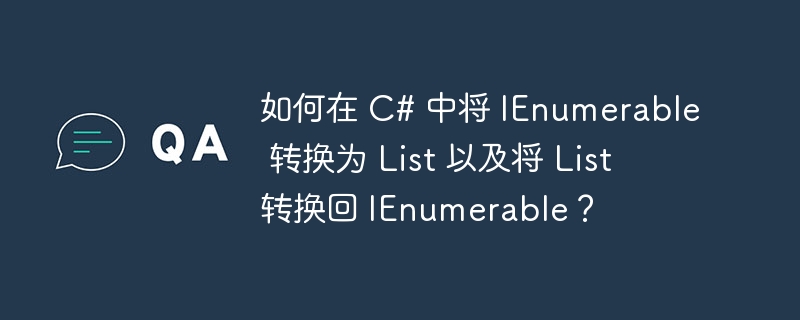

IEnumerable is an interface that defines a single method GetEnumerator() that returns the IEnumerator interface. It is the basic interface for all enumerable, non-generic collections.
This applies to read-only access to collections that implement IEnumerable, which can be used with a foreach statement.
The List class represents a list of objects that can be accessed by index. It is located under the System.Collection.Generic namespace.The List class can be used to create collections of different types, such as integers, strings, etc. The List class also provides methods for searching, sorting, and manipulating lists.
static void Main(string[] args) {
List list = new List();
IEnumerable enumerable = Enumerable.Range(1, 5);
foreach (var item in enumerable) {
list.Add(item);
}
foreach (var item in list) {
Console.WriteLine(item);
}
Console.ReadLine();
}1 2 3 4 5
Convert List Output
static void Main(string[] args) {
List list = new List();
IEnumerable enumerable = Enumerable.Range(1, 5);
foreach (var item in enumerable) {
list.Add(item);
}
foreach (var item in list) {
Console.WriteLine(item);
}
IEnumerable enumerableAfterConversion= list.AsEnumerable();
foreach (var item in enumerableAfterConversion) {
Console.WriteLine(item);
}
Console.ReadLine();
}1 2 3 4 5 1 2 3 4 5
The above is the detailed content of How to convert IEnumerable to List and List back to IEnumerable in C#?. For more information, please follow other related articles on the PHP Chinese website!
 What system is qad?
What system is qad?
 How to solve dns failure
How to solve dns failure
 How to deal with garbled Chinese characters in Linux
How to deal with garbled Chinese characters in Linux
 What does frame rate mean?
What does frame rate mean?
 The difference between access and trunk ports
The difference between access and trunk ports
 How to connect broadband to server
How to connect broadband to server
 How to open state file
How to open state file
 Can Douyin sparks be lit again if they have been off for more than three days?
Can Douyin sparks be lit again if they have been off for more than three days?




